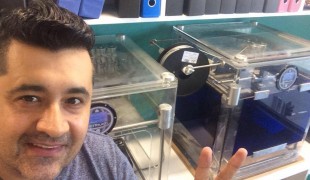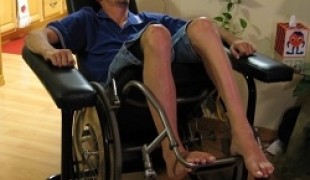- 13044
- 688
- 14
- 19
- 1
- Help Ukraine
About the solution
“We know that sometimes, helping people do the simplest tasks can have a tremendous impact, that's why our team created the Carry Crutches" said Tomas Garces, a design engineer at General Electric Firstbuild and member of Team Carry Crutches. "To have a person on the team who has a need for the device was integral to our design process and we look forward to seeing how people on Thingiverse improve upon it.”
The team designed a 3D printed gimbal inspired by those used to steady a camera on an aerial drone. The team developed two versions of the cup holder: a mechanical version that costs only $15 in materials and combines 3D printed parts with ball bearings, and an electronic version features a Raspberry Pi, servo motors and an accelerometer and costs $30 to build.
Makerbot made available several free 3D designs for assistive devices and challenged Thingiverse makers to improve on them and contribute further designs that could improve the quality of life for people like Lathrop. The 3D designs were based on prototypes from the Bay Area Makeathon for assistive technology, a 72-hour event that took place in September 2015 organized by Tikkun Olam Makers (TOM) and United Cerebral Partners of the North Bay and sponsored by Google.
The goal of the Makeathon was to bring together people with intimate or first-hand knowledge of real-world challenges and those with the engineering and maker skills to provide solutions.
They also got to work directly with people with disabilities, who often can't afford assistive devices, or can’t find ones design to suit their individual needs.
Adapted from: http://bit.ly/2ghr4vf
More info: http://www.thingiverse.com/thing:1018055
What about you, do you have any solutions? Please share them with the Patient Innovation community!
This solution shall not include mention to the use of drugs, chemicals or biologicals (including food); invasive devices; offensive, commercial or inherently dangerous content. This solution was not medically validated. Proceed with caution! If you have any doubts, please consult with a health professional.
DISCLAIMER: This story was written by someone who is not the author of the solution, therefore please be advised that, although it was written with the utmost respect for the innovation and the innovator, there can be some incorrect statements. If you find any errors please contact the patient Innovation team via info@patient-innovation.com
-
-
360
-
0
-
4708

HU-GO - a 3D printed wheelchair
MOVING IN A WHEELCHAIR: Moving using a wheelchair.
Cervical spinal cord injury/Tetraplegia
3d Printed
Walking Aid (wheelchair/walker/crutches)
Restoring mobility
Promoting self-management
Promoting inclusivity and social integration
Maintaining Balance and Mobility
Preventing (Vaccination, Protection, Falls, Research/Mapping)
Neurology
Orthopedics
Rheumatology
Mobility issues
Solutions for Disabled people
Australia
-
-
-
563
-
0
-
9408

Wheelchair Accessible Recliner
MOVING IN A WHEELCHAIR: Moving using a wheelchair.
CAREGIVING
Cervical spinal cord injury/Tetraplegia
Walking Aid (wheelchair/walker/crutches)
Managing pain
Promoting self-management
Preserving Organ Function
Promoting inclusivity and social integration
Maintaining Balance and Mobility
Restoring Blood Circulation
Preventing (Vaccination, Protection, Falls, Research/Mapping)
Internal Medicine
Neurology
Orthopedics
Rheumatology
United States
-
-
-
292
-
0
-
3487

Girl builds cane to help blind people
WALKING WITH A WALKING AID: Walking with a walking aid
Blindness
3d Printed
Walking Aid (wheelchair/walker/crutches)
Assistive Daily Life Device (to help ADL)
App (Including when connected with wearable)
Vision problems
Promoting self-management
Maintaining Balance and Mobility
Preventing (Vaccination, Protection, Falls, Research/Mapping)
Internal Medicine
Ophthalmology
Orthopedics
United Kingdom
-
 en
en
Kailee Lockman • Tue, 11/05/2019 - 12:24
I think this is the perfect thing for such special people who have problem in walking or lost their legs in any way. I appreciate the struggles behind such inventions. Well, I visit website to get help online for such topics by going online which seems perfect practice for me.